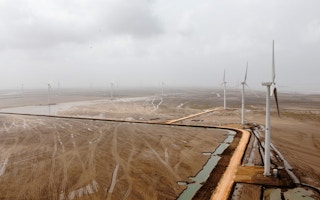The gigantic turbines of a wind farm whirring in unison dominate the barren landscape of Mirpur Sakro Taluqa on the banks of the Indus delta in Thatta district.
On 11 October Tenaga Generasi Limited’s 49.5 MW wind farm began commercial operations, bringing Pakistan’s total wind generation capacity to 630 MW.
This region of Sindh province is virtually uninhabited as the land is too saline for cultivation and freshwater is scarce. “At high tide, seawater comes right up to the plant site,” remarks Hafeez-ur-Rahman, project adviser for the company’s wind farm.
Pakistan’s Alternative Energy Development Board (AEDB), the government agency responsible for renewable power, has leased the land to private developers for a twenty-year concession period to develop wind resources along the Gharo-Keti Bunder wind corridor.
TGL’s wind farm consists of 31 turbines imported from Germany, spread over an area of 20 square kilometres. Hafeez-ur-Rahman estimates that the wind farm can produce enough electricity to power 50,000 urban Pakistani homes.
The Pakistan Meteorological Department claims the Gharo wind corridor’s commercially exploitable electricity generation potential is 11,000 MW. Unfortunately, transmission infrastructure has failed to keep pace with wind power development in the region.
The bottleneck
“One of the biggest challenges for integration of renewable energy sources is the necessity of establishing new transmission lines to carry power from renewable energy power plants to the national grid” says Hafeez-ur-Rahman.
“A single 132 kV transmission line is currently available to evacuate power from the three operational wind power plants in the Gharo wind corridor. However, two more wind farms are expected to come online by early next year… some wind turbines will be forcibly shut down as the single transmission line cannot accommodate the output of all the wind power,” he explains.
While wind power plants are usually located in remote areas with low population density, electricity demand is concentrated in densely populated urban areas. Transporting electricity over longer distances also results in greater power loss.
“Our grid is prone to black-outs and outages due to an integrated, centralised system with faults on the generation side disrupting the system at large” says Hasan Saeed, an energy expert at Engro’s New Ventures Division.
Hasan believes smart grids may be the solution to Pakistan’s grid infrastructure challenges. Smart grids allow utility companies to accurately predict peak electricity demand and takes measures to reduce household electricity use during those peaks to avoid blackouts.
Arnulf Grubler, professor of energy and technology at Yale University explains, “During the screening of a popular television program or sporting event, people all over the country turn on their televisions at the same time. This sudden spike in energy demand stresses the grid and can cause brownouts”.
Conserving electricity during peak times can shift peak demand to off-peak periods resulting in a smoother load profile. Since peak electricity is more expensive than non-peak power, customers can save money when they reduce energy use during peak times and utilities can accommodate greater renewable energy capacity in the generation mix.
“
Our grid is prone to black-outs and outages due to an integrated, centralised system with faults on the generation side disrupting the system at large.
Hasan Saeed, energy expert, Engro
While the AEDB has been tasked with the rather unambitious goal of producing 5 per cent of Pakistan’s power from renewable resources by 2030, a USAID study found that almost 50 per cent of the electricity to the national grid could be supplied by a wind and solar PV with more sophisticated forecasting techniques and minor changes to the grid.
Role of the private sector
The TGL wind farm cost US$118 million and was partially financed by the International Finance Corporation (IFC), the private sector arm of the World Bank, and the Overseas Private Investment Corporation (OPIC), a US government development finance institution. Local financing partners included Habib Bank and Soneri Bank.
Wind power is an attractive investment opportunity for investors due to the prospect of stable returns because although wind varies seasonally, annual wind patterns are well-established.
Internationally, the cost of wind power has steadily declined over the past few years. While Pakistan’s initial wind power projects received a tariff of Rs. 14.3kWh, future wind power plants can expect to produce electricity at an even lower cost of around Rs. 5 kWh making them cheaper than most traditional fossil fuel sources.
Socio-economic and environmental impacts
During the construction phase, the TGL’s wind farm was hired all its unskilled labour locally. However, the operations and maintenance phase requires less than 20 full-time employees and therefore prospects for long-term job creation through wind power expansion are dim. Infrastructure development in the form of new roads and transmission lines will connect the neglected region to larger cities and could result in new economic prospects for the nearby communities.
Wind power is considered integral to a climate-friendly, carbon-free future. According to IFC’s assessment, the electricity generated by TGL’s 49.5 MW wind farm will displace about 55,000 tonnes of CO2 per year. The company is also hoping to register the project under United Nations Framework Convention on Climate Change’s (UNFCCC) Clean Development Mechanism (CDM) to earn carbon credits.
This story was published with permission from The Third Pole. Read the full story.










